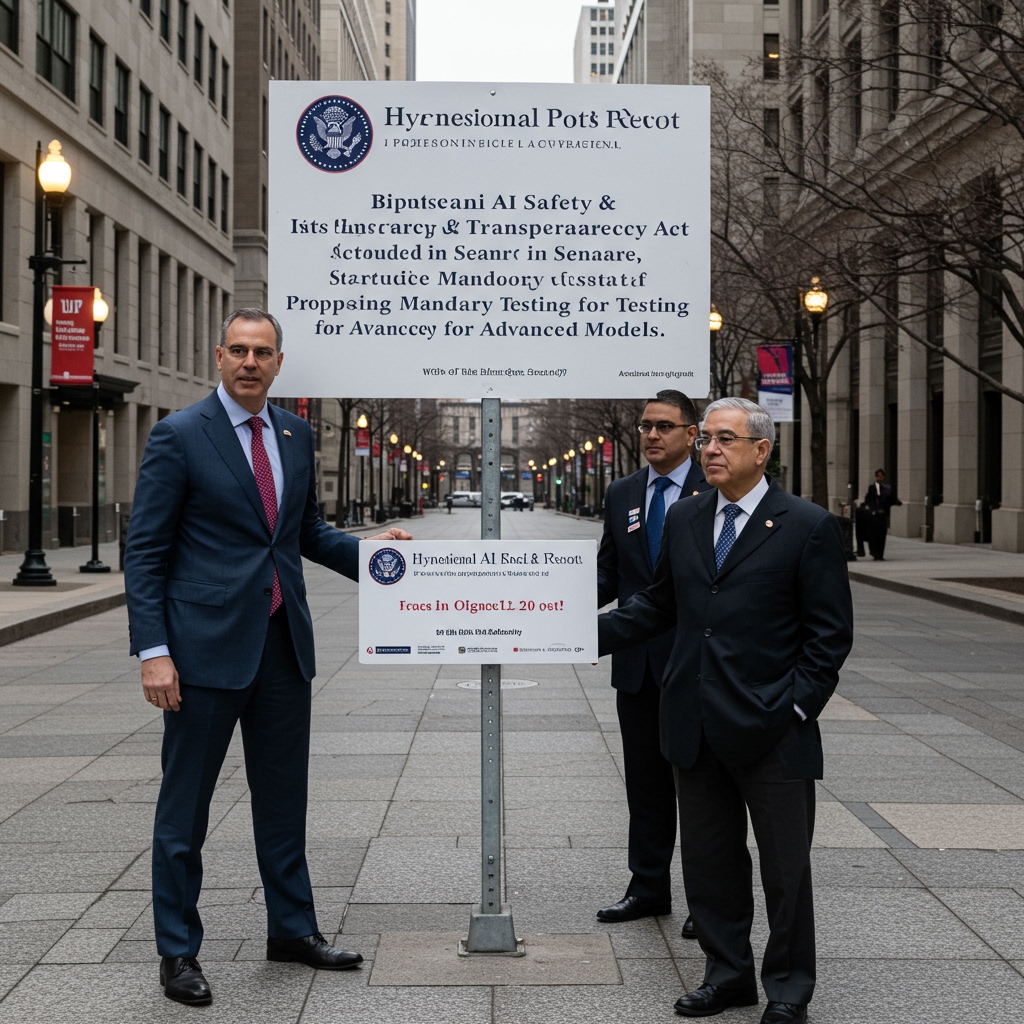Washington D.C. – A significant legislative effort aimed at establishing federal guardrails for the rapidly evolving field of artificial intelligence was formally launched in the U.S. Senate on March 28th.
Spearheaded by Senators Maria Cantwell (D-WA) and Todd Young (R-IN), the bipartisan “AI Safety & Transparency Act of 2025” was introduced, signaling a serious intent on Capitol Hill to address the potential risks associated with advanced AI systems.
The bill represents a critical step in the ongoing congressional deliberation on how to best regulate artificial intelligence, particularly focusing on safety and transparency for the most powerful models.
Core Provisions of the Bill
The AI Safety & Transparency Act of 2025 lays out several key requirements designed to ensure the responsible development and deployment of advanced AI models. Central among these are mandates for rigorous safety testing and comprehensive disclosure requirements for developers. These stipulations specifically target large language models (LLMs) that exceed a certain computational threshold. The rationale behind focusing on models reaching this threshold is the belief that these systems, due to their complexity and scale, possess capabilities that could potentially pose significant societal risks if not properly understood and mitigated.
The bill does not specify the exact computational threshold in the provided summary but ties the mandatory requirements directly to models surpassing this benchmark. This approach aims to capture the most advanced and potentially impactful AI systems currently being developed or deployed. The required safety tests are envisioned to evaluate potential vulnerabilities, biases, and unintended behaviors of these powerful models before they are widely released. Simultaneously, the disclosure requirements are intended to provide users and policymakers with essential information about the capabilities, limitations, and potential risks associated with these AI systems, fostering greater transparency in the AI ecosystem.
Establishing Standards and Enforcement
To implement these requirements effectively, the proposed legislation calls for the creation of a new interagency task force. This task force is planned to involve key federal agencies, specifically the National Institute of Standards and Technology (NIST) and the Federal Trade Commission (FTC). The collaborative nature of this task force, bringing together NIST’s technical expertise in measurement and standards with the FTC’s regulatory and enforcement authority, is crucial for the bill’s objectives.
The task force will be charged with the vital role of establishing technical standards for the safety testing and disclosure requirements outlined in the bill. This involves defining methodologies for evaluating AI model safety and determining the scope and format of necessary disclosures. Furthermore, the task force will be responsible for enforcing compliance with the new regulations. This enforcement mechanism is intended to ensure that developers of high-computation LLMs adhere to the mandatory testing and transparency provisions, holding them accountable for the safety implications of their technology. The collaboration between NIST and the FTC is expected to facilitate the development of feasible yet effective standards and enforcement mechanisms that can adapt to the rapidly changing AI landscape.
Context and Rationale
The introduction of the AI Safety & Transparency Act of 2025 occurs amidst growing concerns from policymakers, experts, and the public about the accelerating pace of AI development and its potential impacts on society. Issues such as the proliferation of misinformation, the potential for sophisticated cyberattacks, the exacerbation of societal biases, and the opaque nature of complex AI decision-making processes have underscored the perceived need for regulatory action. Capitol Hill has seen numerous hearings, proposals, and discussions around AI, but this bipartisan Senate bill marks a significant legislative vehicle moving forward.
Senators Cantwell and Young’s collaboration on this bill highlights the bipartisan recognition of the urgency and importance of addressing AI safety at the federal level. The bill’s focus on mandatory testing and transparency for the most powerful AI models reflects a proactive approach to mitigating risks before they manifest on a wide scale. It aims to create a framework that fosters responsible innovation by building a foundation of safety and trust in advanced AI systems.
Industry Perspectives
The proposed legislation has elicited a mixed response from the technology industry, particularly from major firms involved in AI development. Companies like ApexTech and GlobalMind have publicly commented on the bill, expressing a desire for regulatory clarity. They acknowledge the importance of establishing clear rules of the road for AI development, stating that predictable regulations can foster responsible innovation and public trust.
However, industry stakeholders have also voiced concerns, primarily regarding the potential implementation burdens associated with the mandatory testing and disclosure requirements. There are questions about the practicality and feasibility of developing and applying standardized tests to diverse and rapidly evolving AI models. Companies are also keen to ensure that regulations are flexible enough not to stifle innovation or disproportionately impact smaller developers. The debate between the need for robust safety measures and the desire to maintain a dynamic innovation environment is likely to continue as the bill progresses through the legislative process.
Looking Ahead
The introduction of the AI Safety & Transparency Act of 2025 is a pivotal moment in the US legislative response to artificial intelligence. While the bill faces the standard legislative hurdles, including committee review and potential amendments, its bipartisan support from key senators like Cantwell and Young provides it with significant momentum.
Passage of this bill would establish a foundational federal framework for AI safety and transparency, focusing initial efforts on the most powerful models. It underscores a growing consensus that voluntary guidelines may be insufficient to manage the risks posed by rapidly advancing AI. The bill’s journey through Congress will be closely watched by industry, civil society groups, and international partners, as it could set a precedent for AI regulation in the United States and potentially influence approaches globally. Its ultimate form will likely be shaped by further debate, expert input, and negotiations across the political spectrum.





